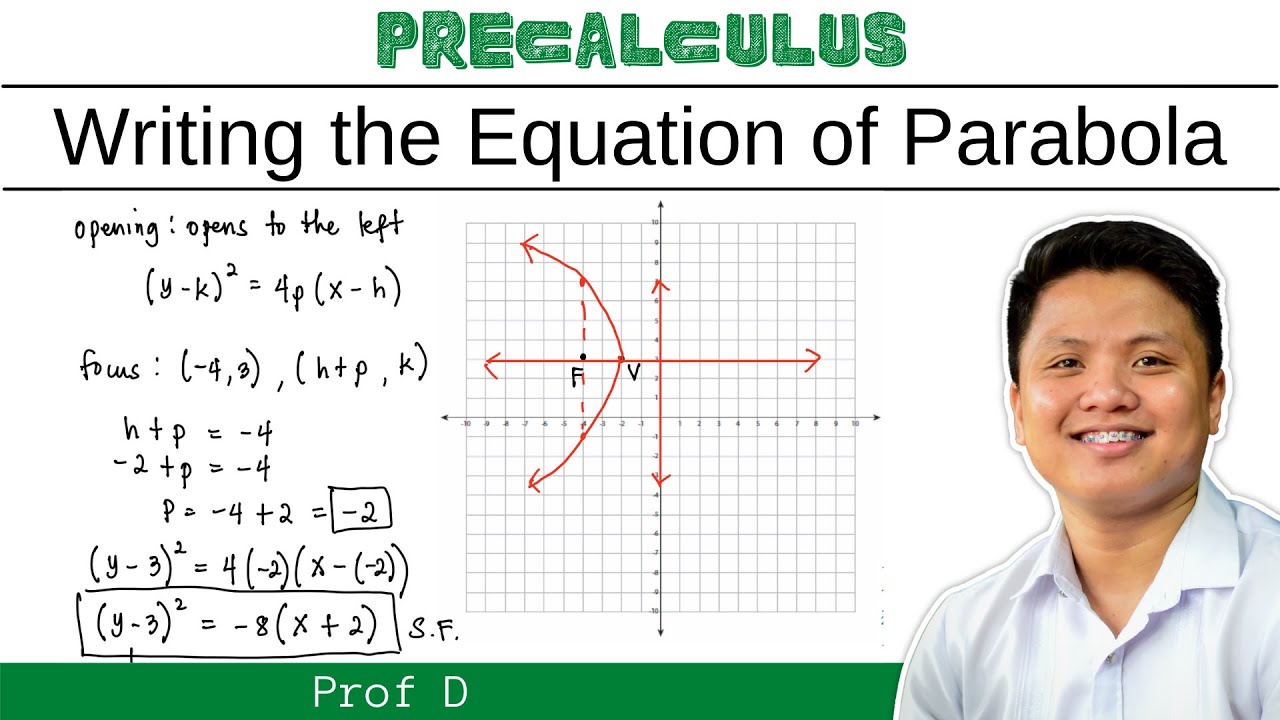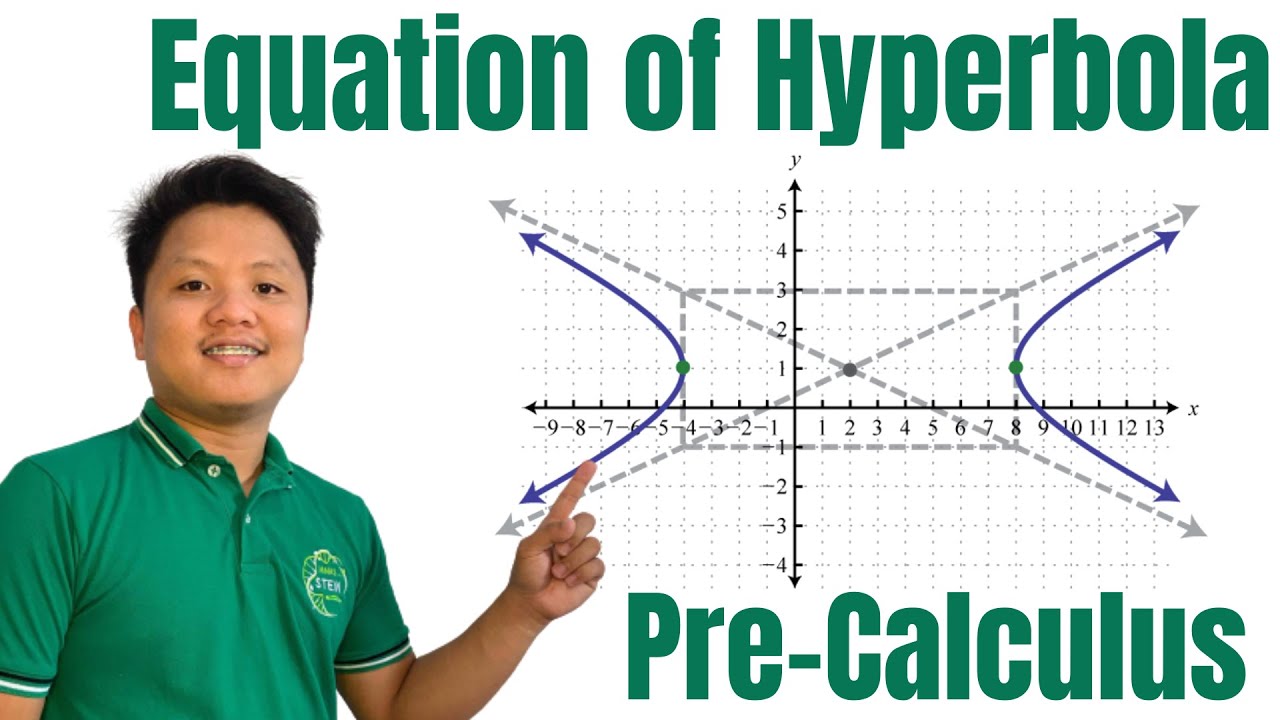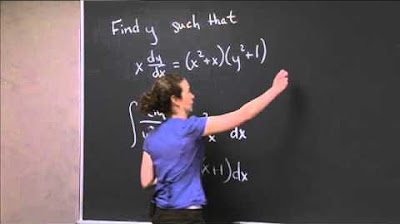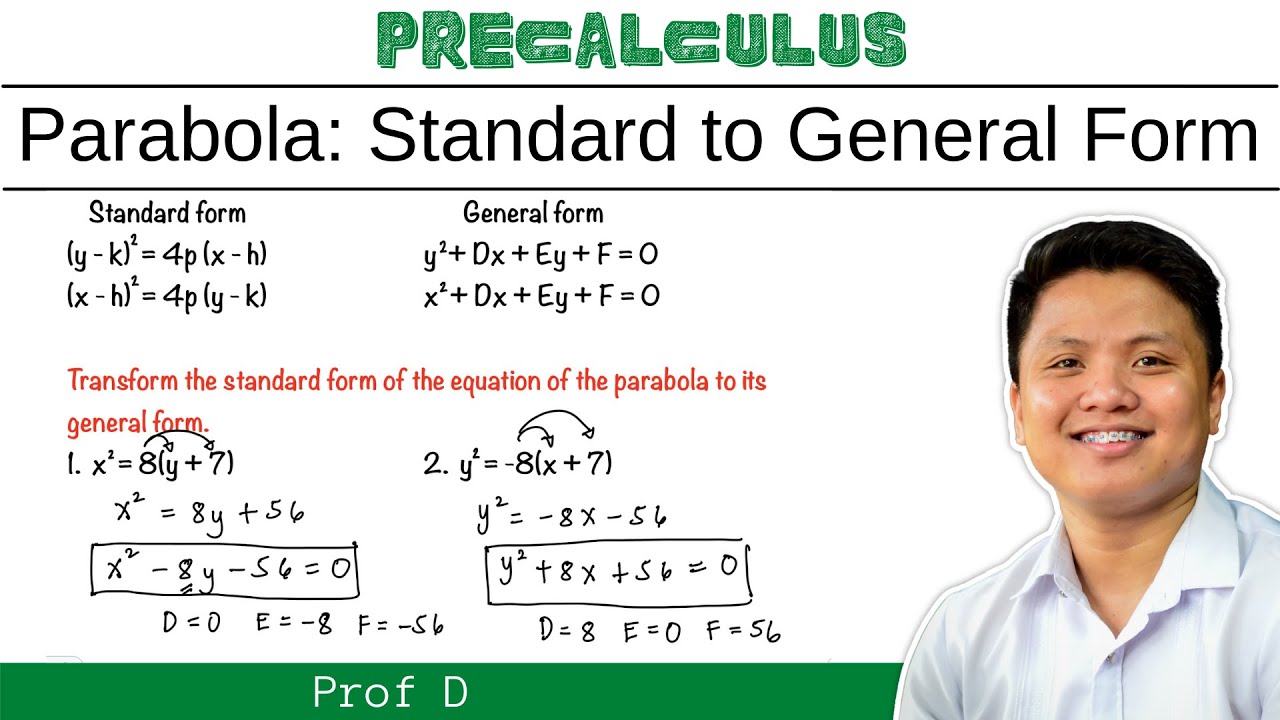Transforming General Form to Standard Form of Parabola | @ProfD
TLDRIn this educational video, Prof D teaches viewers how to transform the general form of a parabolic equation into its standard form. The process involves two general forms, with the first being y plus d times x plus e equals zero, and the second being x squared plus dx plus e times y plus f equals zero. Through step-by-step examples, Prof D demonstrates how to identify the vertex and the value of p, providing a clear understanding of the mathematical concepts involved. The video concludes with a call for viewers to ask questions in the comments section, ensuring a comprehensive learning experience.
Takeaways
- 📚 The video aims to teach viewers how to transform the general form of a parabolic equation into its standard form.
- 📐 There are two general forms of parabolic equations discussed: one with 'x' squared and the other with 'y' squared.
- 🔍 To convert the general form to standard form, the script demonstrates completing the square for both 'x' and 'y' terms.
- ⚖️ The process involves moving terms from one side of the equation to the other and factoring out constants.
- 🔢 The script provides step-by-step examples to illustrate the conversion process from general to standard form.
- 📈 Identifying the vertex of the parabola is a key part of the process, which is derived from the standard form of the equation.
- 📍 The value of 'p', which represents the distance from the vertex to the focus or directrix of the parabola, is also determined.
- 🔗 The script emphasizes the importance of correctly identifying coefficients and completing the square to find the vertex and 'p'.
- 📝 Each example concludes with the standard form of the equation, the vertex coordinates, and the value of 'p'.
- 🤔 The video encourages viewers to ask questions or seek clarifications in the comments section if needed.
- 👋 The presenter, Prof D, signs off with a friendly farewell, inviting viewers to join him in future videos.
Q & A
What is the purpose of the video?
-The purpose of the video is to teach viewers how to transform the general form of the equation of a parabola into its standard form and to identify the vertex and the value of 'p'.
What are the two general forms of the equation of a parabola mentioned in the video?
-The two general forms are: 1) y + d = (x + e)^2 + f and 2) x^2 + dx + e = (y + f)^2 + g.
What is the standard form of a parabola's equation?
-The standard form of a parabola's equation is either (y - k)^2 = 4p(x - h) or (x - h)^2 = 4p(y - k), depending on whether the parabola opens up and down or left and right respectively.
How does the video demonstrate the transformation of the general form to the standard form?
-The video demonstrates the transformation through step-by-step examples, showing how to rearrange terms, complete the square, and identify the vertex coordinates and the value of 'p'.
What is the vertex of a parabola?
-The vertex of a parabola is the point (h, k) where the parabola turns. It is the minimum or maximum point on the graph depending on the orientation of the parabola.
What is the value of 'p' in the standard form equation and what does it represent?
-The value of 'p' in the standard form equation represents the distance from the vertex to the focus or the directrix of the parabola. It is calculated as 1/4 of the coefficient of the linear term after completing the square.
How does the video handle the example where the equation is x^2 - 8y - 56 = 0?
-The video rearranges the equation to x^2 = 8y + 56, completes the square to get x^2 = 8(y + 7), and then identifies the vertex as (0, -7) and the value of 'p' as 2.
In the second example, what is the equation and how is it transformed?
-The second example's equation is y^2 + 8x + 48 = 0. The video rearranges it to y^2 = -8x - 48, completes the square, and transforms it into the standard form, identifying the vertex as (-6, 0) and the value of 'p' as -2.
What is the process of completing the square and why is it used?
-Completing the square is a mathematical technique used to transform a quadratic equation into a perfect square trinomial plus or minus a constant. It is used to rewrite the equation in a form that makes it easier to identify the vertex and the direction in which the parabola opens.
How does the video address the example with the equation x^2 - 4x + 12y + 4 = 0?
-The video rearranges the equation, completes the square for the x terms, and then balances the equation by adding and subtracting the necessary constants to achieve the standard form. It identifies the vertex as (2, 0) and the value of 'p' as -3.
What is the final example presented in the video and what are the results?
-The final example is the equation y^2 + 6y + 20x + 89. The video completes the square for the y terms, balances the equation, and transforms it into the standard form, finding the vertex as (-3, -4) and the value of 'p' as -5.
Outlines
📚 Introduction to Transforming Parabola Equations
In this segment, the instructor begins by welcoming viewers back to the channel and introducing the topic of converting the general form of a parabola's equation into its standard form. Two general forms of the parabola equation are presented: one with 'y' squared and the other with 'x' squared. The instructor then proceeds to demonstrate the transformation process with example number one, which involves the equation 'x squared minus eight y minus 56 equals zero'. The goal is to identify the vertex and the value of 'p', which represents the distance from the vertex to the focus or directrix of the parabola. The instructor guides the viewers through the algebraic steps to reach the standard form of the equation and to find the vertex coordinates and 'p' value.
🔍 Completing the Square for Parabola Equations
This paragraph continues the lesson on transforming parabola equations into their standard form. The instructor provides a second example, 'y squared plus eight x plus 48 equals zero', and explains the process of completing the square to find the standard form. The focus is on manipulating the equation to isolate 'y' squared on one side and then balancing the equation by factoring out constants and completing the square for 'x'. The instructor then calculates the vertex coordinates and the value of 'p' for this equation. The explanation includes algebraic steps such as factoring out negative eight, dividing the constant term by the coefficient of 'x', and simplifying the equation to find the vertex and 'p'.
📘 Advanced Transformation with Multiple Examples
The third paragraph delves deeper into the transformation process with more complex examples. The instructor presents the equation 'x square minus four x plus twelve y plus four equals zero' and walks through the steps of completing the square for 'x'. The process involves moving terms to the left side, dividing the coefficient of the middle term by two, and squaring the result to balance the equation. The instructor then simplifies the equation to find the vertex and the value of 'p'. The explanation is detailed, showing each algebraic manipulation and the reasoning behind it. The goal is to reach the standard form of the equation and identify the vertex coordinates and 'p'.
📌 Final Example and Conclusion
In the final paragraph, the instructor wraps up the lesson with a fourth example, 'y square plus six y plus 20x plus 89'. The focus is on completing the square for 'y' and then balancing the equation with 'x'. The instructor demonstrates how to create a perfect square trinomial on the left side and how to adjust the right side of the equation accordingly. The process includes taking the square root of the first term, copying the sign of the middle term, and coordinating the square root of the last term to form a binomial. The instructor then simplifies the equation to find the vertex and the value of 'p'. The video concludes with an invitation for viewers to ask questions or seek clarification in the comments section, and the instructor signs off with a friendly farewell.
Mindmap
Keywords
💡General form
💡Standard form
💡Parabola
💡Vertex
💡Coefficient
💡Completing the square
💡Factoring
💡Value of 'p'
💡Perfect square trinomial
💡Equation transformation
Highlights
Introduction to transforming the general form of a parabola's equation to its standard form.
Explanation of two general forms of a parabola's equation: y = ax^2 + bx + c and x = ay^2 + by + c.
Standard form transformation for the first general form: (y - k)^2 = 4p(x - h).
Standard form transformation for the second general form: (x - h)^2 = 4p(y - k).
Example 1: Transforming x^2 - 8y - 56 = 0 into standard form and identifying vertex and p.
Completing the square for x^2 - 8y - 56 = 0 to find the standard form.
Vertex identification for the first example: (h, k) = (0, -7).
Calculation of p for the first example: p = 2.
Example 2: Transforming y^2 + 8x + 48 = 0 into standard form and finding vertex and p.
Factoring out negative eight in the equation y^2 + 8x + 48 = 0.
Vertex identification for the second example: (h, k) = (-6, 0).
Calculation of p for the second example: p = -2.
Example 3: Transforming x^2 - 4x + 12y + 4 = 0 into standard form and identifying vertex and p.
Completing the square for x^2 - 4x + 12y + 4 = 0 and simplifying the equation.
Vertex identification for the third example: (h, k) = (2, 0).
Calculation of p for the third example: p = -3.
Example 4: Transforming y^2 + 6y + 20x + 89 into standard form and finding vertex and p.
Transforming y^2 + 6y + 20x + 89 into a perfect square trinomial and simplifying.
Vertex identification for the fourth example: (h, k) = (-4, -3).
Calculation of p for the fourth example: p = -5.
Conclusion of the video with an invitation for questions and comments.
Transcripts
Browse More Related Video

Writing Equation of A Parabola in Standard and General Form | @ProfD

How to find the equation of Hyperbola given its graph

Differential Equation | MIT 18.01SC Single Variable Calculus, Fall 2010

Linear versus Nonlinear Differential Equations

DETERMINING IF AN EQUATION IS A CIRCLE, POINT, OR HAS NO GRAPH | PROF D

Transforming Standard Form to General Form of Parabola | @ProfD
5.0 / 5 (0 votes)
Thanks for rating: